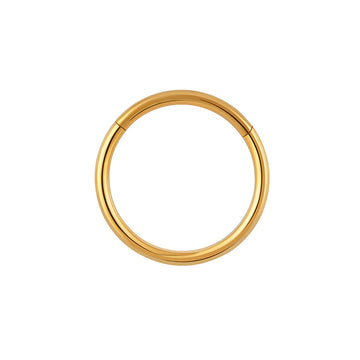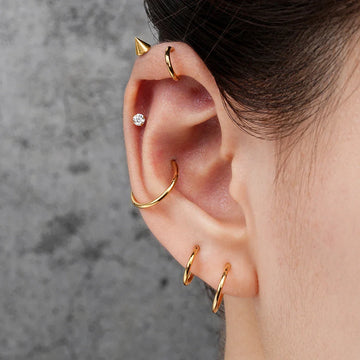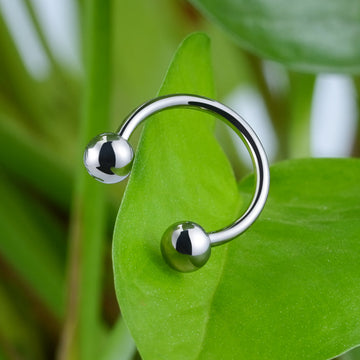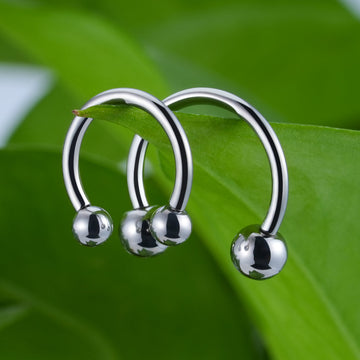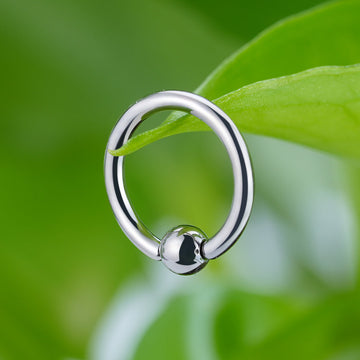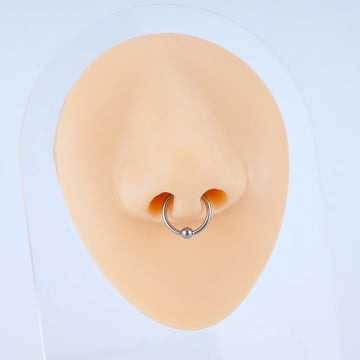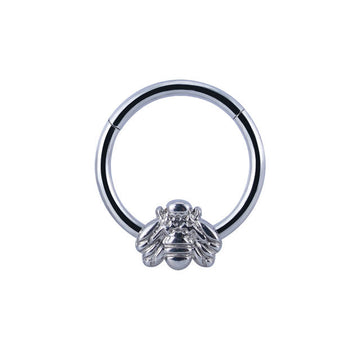Rejected Septum Piercing: How to Tell and What to Do?
Aug 19, 2025
What Is a Septum Piercing?
A Septum piercing is a type of body piercing that passes through the cartilage dividing the nostrils. It is one of the most popular piercings among both men and women. But having a rejected Septum piercing can be a real headache.
Why Does Your Septum Piercing Get Rejected?
Rejection is when your body is rejecting a foreign object and starts to push the jewelry out. There are a variety of reasons why septum piercings may be rejected.
Common reasons for rejection include:
- The piercing is too close to the edge of the septum. This can cause the piercing to migrate out of the septum and eventually be rejected.
- The piercing is too deep. This can cause damage to the tissue and lead to rejection.
- The jewelry is too heavy. This can put unnecessary pressure on the tissue and cause the piercing to reject.
- The jewelry is too thin. Our body tends to reject smaller foreign objects than bigger ones. The standard Septum piercing size is 16 gauge (1.2 mm).
- If the jewelry is not of good quality or is made of materials that your body doesn't like (such as nickel), it can irritate the septum and cause inflammation.
- Lastly, if the piercing is not taken care of properly, it can lead to infection.
If you notice that your piercing is starting to migrate out, it's important to consult with a piercer or doctor. They may be able to change the jewelry for you or give you advice on how to proceed.
Signs of Rejected Septum Piercing
If your Septum piercing is rejected, you may notice one or more of the following signs:
- The jewelry appears to be pushed out of the piercing
- Redness and swelling around the piercing site
- Pain or tenderness at the piercing site
- Crust formation around the piercing
If you notice any of these signs, it's important to see your piercer or a healthcare professional as soon as possible so that they can treat the problem and help you avoid further complications.
Consequences of Rejected Septum Piercing
If you have a rejected Septum piercing, there are a few consequences that you may experience.
First, your piercing may become infected. This is because when the jewelry is rejected from your body, it leaves an open wound. Bacteria can enter this wound and cause an infection.
Second, you may experience pain and swelling around the piercing site. This is because your body is trying to heal the wound and close up the hole created by the piercing.
Third, you may have a permanent scar around the piercing site. This is because when your body heals from a septum-piercing rejection, it will create scar tissue to close up the hole.
Fourth, you may have trouble breathing through your nose if your septum piercing is rejected. This is because the piercing creates a hole in the septum, which separates the nostrils. When this hole is no longer there, it can block airflow and make breathing difficult through your nose.
Suppose you experience any of these consequences after having your septum pierced. In that case, it is important to see a doctor or piercer immediately so that they can treat any infections or injuries you may have.
Rejection vs Infection
When your Septum piercing is healing, it's important to be aware of the difference between rejection and infection.
Rejection is when your body starts to push the jewelry out. On the other hand, infection is when bacteria get into the piercing site and causes problems. Symptoms of infection include redness, swelling, pain, discharge, and changes in color around the piercing.
If you think you might have an infection, it's important to see a doctor right away. They will be able to prescribe antibiotics to help clear it up.
How to Stop the Rejection Process?
You can do a few things to stop the rejection process once it has started.
- Remove the jewelry and contact your piercer or a doctor.
- Try changing to a safer metal, a larger piece of nose jewelry with the help of your piercer or a doctor. However, it is possible that you will be advised to stop wearing septum jewelry, and the piercing heal.
- If you are advised to save the piercing, clean your piercing twice a day with a saline solution. This will help to keep the area clean and free of bacteria. You also need to ensure that you are not using harsh chemicals on your piercing, as this can irritate the area and cause further inflammation.
- If you are advised to stop wearing any septum jewelry for the time being, then just wait and let the piercing heal. You can re-pierce it when it is fully healed.
How to Prevent Rejected Septum Piercing Beforehand?
If you're considering a Septum piercing, it's important to do your research beforehand. There are a few things you can do to help prevent rejected septum piercing beforehand:
- Choose an experienced piercer. Make sure they have experience with septum piercings and know what they're doing.
- Clean your nose thoroughly before your piercing appointment. This will help to reduce the risk of infection.
- Choose high-quality materials for septum piercings. Titanium septum piercing jewelry is the best choice because it is hypoallergenic, durable, and affordable. 14-karat or 18-karat gold is also a good choice, but they are more expensive.
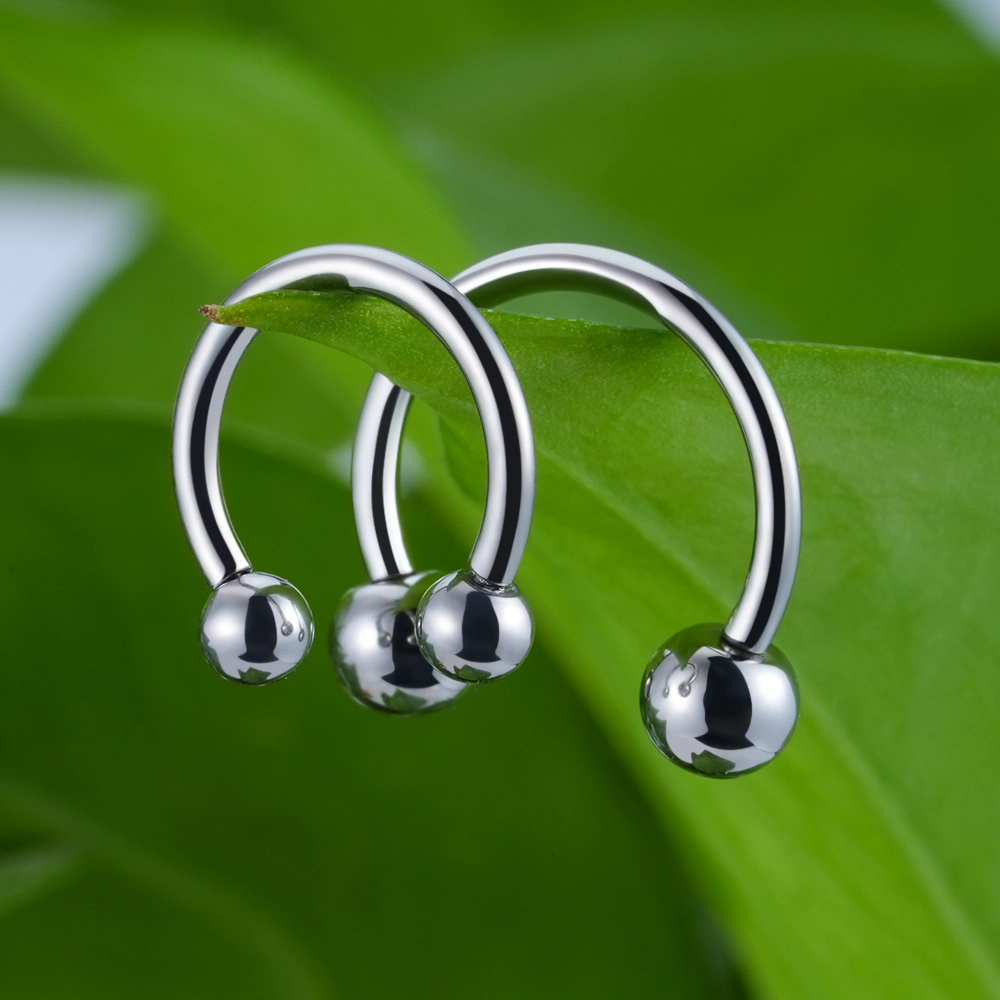
Titanium nose ring curved barbell horseshoe $18.9, SHOP NOW.
- Be aware of the signs of rejection. These include migration, redness, swelling, and pain from the piercing site. Contact your piercer or doctor immediately if you notice any of these signs.
- Follow all aftercare instructions carefully. This includes cleaning the piercing twice a day with a saline solution and avoiding touching or playing with the piercing.
Can You Re-Pierce a Rejected Septum Piercing?
The answer is: yes; re-piercing after rejection is safe! However, you need to make sure that the first rejected septum piercing is fully healed, and that you change to a larger gauge or better materials for nose piercings.
With proper care and precautions, re-piercing your septum after rejection is safe and can be as successful as your first piercing.
There are a few more things to keep in mind in order to ensure a successful piercing and avoid a second rejected septum piercing.
Before getting your Septum pierced again, it's important to consult with a professional piercer. They will be able to assess the situation and determine whether or not your septum is suitable for another piercing. If they give you the green light, follow their aftercare instructions carefully to promote healing and avoid a second rejected Septum piercing.
Once your Septum is done again, clean it regularly and avoid any activities that could cause trauma to the area (such as nose picking!). Contact your piercer immediately if you notice any signs of rejection (migration, redness, swelling).
What Are the Other Risks of Septum Piercing?
1. Infection
You can expect some swelling and redness after a piercing. But if the redness persists or gets worse and you notice extra swelling and/or pus around the area, it's likely infected.
2. Bump
Typically, a raised red bump around the nose piercing is a sign of infection. Make sure to use the treatments above to control the bump -- if it worsens, you could develop a severe systemic infection.
And as a side note, with bumps or other signs of infection, don't remove the piercing! That can cause the hole to close, sealing in the infection.
3. Keloid and Scar
Untreated infections can lead to scar tissue around the piercing. And sometimes, if left untreated, an infection will lead to a buildup of fibrous tissue that causes a scar called a keloid.
Keloids are uncommon, but they can be hard to treat. If you have a noticeable keloid, be sure to consult with a dermatologist for treatment advice.
4. Allergy
It's also possible to have an allergic reaction to the metal jewelry used, so make sure you choose implant-grade titanium nose jewelry or other hypoallergenic metals like 14-karat or 18-karat gold and surgical stainless steel.
5. Smell
In some cases, your piercing may start to smell. If the smell is accompanied by redness and swelling, the piercing is likely infected, and it's a good idea to see a doctor.
If the swelling is older, smells can develop when sebum (skin oil) and dead skin cells mix together. If this is the case, the piercing just needs to be cleaned more regularly.
How Long Does It Take for a Septum Piercing to Heal Completely?
Healing time will depend on each individual, though -- for some people, healing will be complete after 2-3 months. For others, it can take up to eight months. Before it heals, you need to take good care of your piercing to prevent any discomfort.
Safe Materials for Septum Piercing Jewelry
One of the most important factors in the healing process of nose piercings is the material you choose. If you're considering a nose piercing, here are some of the best metals for Septum piercings.
1. Implant-Grade Titanium

Nose piercing clicker titanium septum ring 16G in gold and silver $22.9, SHOP NOW.
Titanium is an element that is completely hypoallergenic, so it's probably the best material for nose rings, especially if you have sensitive skin.
Implant-grade titanium is the purest form and will not change or corrode if it's exposed to skin or bodily fluids. It is durable, hypoallergenic, and non-corrosive.
Price Range: About $15-$40.
Pros:
- Approved by the Association of Professional Piercers
- Won't cause allergic reactions
- Is scratch-resistant and won't fade
Cons:
- Not as valuable as gold, silver, or platinum
- Doesn't sparkle quite as much as other metals
2. 14-Karat or 18-Karat Gold

14K gold hoop with an opal pendant segment clicker nose ring $146.9, SHOP NOW.
If you're looking for a glittering, valuable metal for your nose jewelry, either 14-karat or 18-karat gold may be your answer.
It is also one of the best metals for nose rings that are highly recommended not only by piercing experts but also doctors. Its excellent quality of being inert makes it suitable for first piercings.
However, gold is a fairly soft metal, so it doesn't stand up to scratches and excessive wear. Compared to 14-karat gold, 18-karat gold is more prone to being affected by everyday use as it is softer and is closer to being pure 24-karat gold.
Both of these metals include other metal types in order to make them stronger. In order to avoid skin reactions, look for nickel-free metals.
Price Range: About $30-$200.
Pros:
- One of the most valuable materials
- Will not easily tarnish
- Offers plenty of sparkles
- Is easy to engrave or use to set stones
Cons:
- May contain non-hypoallergenic metals
- 18K gold in particular is not very scratch resistant
3. Surgical Stainless Steel
Lots of new piercings are done in stainless steel. This material is affordable and typically doesn't cause reactions. However, even surgical-grade steel contains small amounts of nickel that could cause allergic reactions in those with skin sensitivities.
It is incredibly resistant to corrosion and will keep its shine for years.
If you're considering steel, 316L or 316 LVM steel is probably your best choice. Both names stand for the same surgical steel material, but the "VM" stands for"vacuum melt," or the way the steel is produced.
Price Range: About $10-$40.
Pros:
- Very affordable
- Common enough that you'll have plenty of jewelry choices
- Extremely durable and resistant to damage and corrosion
Cons:
- May cause reactions in those with nickel allergies
- Not considered as valuable as some other materials
How to Take Care of Septum Piercing?
- Be gentle when blowing your nose. Blowing your nose too hard can irritate the piercing site and slow down the healing process. Be gentle when blowing your nose, and avoid using tissues or other materials that may get caught on the jewelry.
- Take care to avoid contaminating the piercing.
- Avoid touching it or applying makeup very close to it.
- Avoid getting in the water that might be dirty.
- Clean your piercing twice per day using a saline solution made for wound cleaning or soap and water to prevent infection.
- Avoid ointments as they prevent necessary air circulation.
- And of course, make sure to avoid snagging on clothes or towels.
- Wear loose clothing. Avoid wearing tight clothing or clothing that may rub against the piercing, as this can cause irritation and slow down the healing process.
- Use hypoallergenic jewelry like implant-grade titanium and 14- or 18-karat gold. Surgical-grade steel may contain small amounts of nickel that could cause allergic reactions.
- Don't move the piercing unless you're cleaning it. Pulling on a piercing early in healing is painful, but it also can get in the way of healing or damage the piercing itself.
- Wait until your piercing heals before changing out your jewelry.
- Watch for potential signs of infection and consult your piercer or doctor if it becomes infected.
You should ensure you get pierced by someone experienced and reliable who utilizes the right cleaning and sterilization procedures. You’ll also need to choose high-quality jewelry that you aren’t allergic to. After you get your piercing, be sure to follow all instructions from your piercer.
How to Clean Septum Piercing?
It is recommended to use sterile saline that you buy from the store, rather than homemade saline, for cleaning your piercings. Homemade saline may be too salty for delicate piercing sites, leading to dryness and delayed healing.
Using mild, fragrance-free soap and water to clean your piercing site is also an option.
If you prefer homemade salt solution. You can start by mixing 1/2 teaspoon of non-iodized salt with one cup of distilled or boiled (for at least 20 minutes) water. You may choose to use less of the salt mixture like 1/4 to 1/8 teaspoon if you want a weaker solution that’s less likely to burn or sting. Stir the solution until it dissolves.
If you see signs of infection, you can also use antiseptic solutions, such as betadine, isopropyl alcohol, or diluted hydrogen peroxide. However, avoid using them for daily cleaning as they can damage cells.
Then proceed with the following steps to clean your piercing:
- Soak a cotton ball, a paper towel, or a non-plush cloth with the solution. Avoid fabrics that could snag and pull the jewelry or leave fibers behind. Gently saturate the piercing and cleanse it. Don't remove the jewelry!
- If you have a sterile saline wound wash that you buy from stores, then spay it while healing.
- Ensure you cleanse the piercing of any discharge or crusty material.
- Take clean gauze or cotton swabs and pat the area dry.
Your piercer should give you detailed instructions on how to keep your piercing clean once it has been placed.
Conclusion
If you have a rejected Septum piercing, it's important to consult with a professional piercer to determine the best course of action.
In some cases, the rejected Septum piercing may be saved, but in other cases, it may need to be completely removed. Regardless of what needs to be done, it's important to seek professional help to avoid further complications.
Read More
A Complete Guide: Septum Piercing Price, Pain, Healing, Aftercare…





